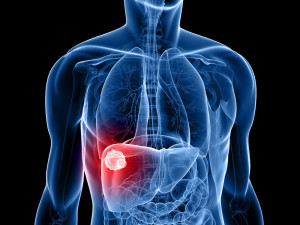Introduction
It is important to realize that an abscess is a local accumulation of pus in an organ. In the beginning pus accumulates in a cyst-like structure. This maybe small and can be difficult to diagnose. However, as time goes on the pathogens in this abscess cavity are exerting pressure and are eating their way more and more into the healthy surrounding liver tissue.
In general, a CT scan will visualize of a liver abscess. The end result can be that an overwhelming infection suddenly can gain entrance into the blood stream at which point the patient gets extremely sick with septicemia.
Generally speaking, a liver abscess can originate from a variety of conditions as follows.
Common conditions that can cause a liver abscess
- Infection in bile ducts can occur when a gallstone is present. Meanwhile the infection can travel against the bile flow into the liver tissue (=ascending cholangitis).
- Bacteria can reach the liver through the systemic circulation in the case of septicemia (blood poisoning with bacteria).
- Another mode of transmission is via the portal vein system in the case of appendicitis or diverticulitis, where the pus from an appendicitis or from a case of diverticulitis of the colon reaches the liver through the portal vein system.
- Finally, sharp or blunt trauma can cause an abscess. In the case of a stab wound or a gun shot wound the bacteria enter directly into the liver tissue.
Liver Abscess
Blunt trauma may be the cause of a liver abscess
In the case of blunt trauma from a blow to the upper abdomen a hematoma forms on the surface or inside the liver. A hematoma is a blood collection in a local area. It attracts bacteria that happen to travel through the blood. Normally white blood cells remove bacteria immediately. However, in a hematoma, there is no circulation of white blood cells, but blood serves as an ideal growth medium for the bacteria, which by chance have found their way into the liver. After they have multiplied enough, the digestive enzymes eat a cavity into the liver tissue, where pus forms and a membrane demarcates it from the healthy tissue. In due time this forms the wall of the abscess.
Common bacteria present in liver abscess
Frequently the pathogens that cause liver abscesses are quite varied. First, common bacteria are streptococci or staphylococci, which usually originated systemically through the blood stream. Second, abscesses due to the infected biliary tract grow E.coli and Klebsiella bacteria. Third, an intraabdominal infection that the the portal vein system transmits to the liver often contains E. coli and anaerobic bacteria. Furthermore, an amebic abscess from Entamoeba histolytica( which is a parasite) has a better prognosis than the bacterial abscesses and responds well to appropriate medication.
Symptoms
When there are several abscesses in the liver, the symptoms are acute with acute right upper abdominal pain, vomiting, nausea, weight loss, a fever and weakness. In addition, the patient might also experience right chest pain (due to pleuritic irritation) and might be jaundiced, particularly with biliary tract disease. In other cases with a single liver abscess it might take several weeks to see symptoms develop. On the other hand, there might be only a fever, malaise, weight loss and nausea. Then gradually the other symptoms develop as more and more pus is produced in the abscess cavity.
Diagnosis
Similarly, before treatment can be instituted, the surgeon will want to be absolutely sure where the abscess is. A CT scan or MRI scan are the most sensitive tests, but an ultrasound of the liver can detect abscesses of more than 2 cm (=0.8 inch) in diameter.
The imaging studies are in addition to the normal basic history and physical examination. Blood tests would also be useful with high white blood cell readings and elevated liver enzymes.
Treatment
Treatment depends on the pathogen, which has caused the abscess. For instance, an amebic abscess will respond well to chemotherapy with metronidazole, emetine or chloroquine. Other (bacterial) abscesses will be treated with the appropriate antibiotic first and often with percutaneous needle aspiration pus can also be sucked out. Surgery is reserved only for those patients, where these other measures did not resolve the abscess. Usually for prevention of recurrence patients are put on antibiotics for several weeks.
Complications
The abscess can rupture or spread locally. This can cause such things as a subphrenic abscess( an abscess between the liver and the right diaphragm), a rupture into the right pleural cavity, into the right lung, bleeding into the abscess, rupture of the abscess into the peritoneal cavity with development of generalized peritonitis and septicemia. Despite the best therapy the mortality rate of a liver abscess is still between 10% and 30%.
References
1. DM Thompson: The 46th Annual St. Paul’s Hospital CME Conference for Primary Physicians, Nov. 14-17, 2000, Vancouver/B.C./Canada
2. C Ritenbaugh Curr Oncol Rep 2000 May 2(3): 225-233.
3. PA Totten et al. J Infect Dis 2001 Jan 183(2): 269-276.
4. M Ohkawa et al. Br J Urol 1993 Dec 72(6):918-921.
5. Textbook of Primary Care Medicine, 3rd ed., Copyright © 2001 Mosby, Inc., pages 976-983: “Chapter 107 – Acute Abdomen and Common Surgical Abdominal Problems”.
6. Marx: Rosen’s Emergency Medicine: Concepts and Clinical Practice, 5th ed., Copyright © 2002 Mosby, Inc. , p. 185:”Abdominal pain”.
7. Feldman: Sleisenger & Fordtran’s Gastrointestinal and Liver Disease, 7th ed., Copyright © 2002 Elsevier, p. 71: “Chapter 4 – Abdominal Pain, Including the Acute Abdomen”.
8. Ferri: Ferri’s Clinical Advisor: Instant Diagnosis and Treatment, 2004 ed., Copyright © 2004 Mosby, Inc.







